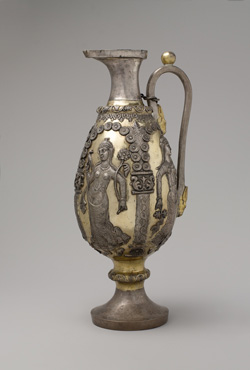Fourteen centuries after the works on display in Byzantium and Islam were created, Byzantine art is flourishing where you might least expect it: the streets of New York. That's where artist Manny Vega displays his large-scale mosaics of saints, heroes, dancers, and conga-drumming angels, all made using true Byzantine techniques.
Vega may be the world's first "Byzantine hip-hop" artist.
"I'm on a campaign to get people to appreciate history again," he said recently. "The art provides an invitation for people to welcome history and innovation in the same voice."
Born in the Bronx in 1956, Vega has been making art since the 1970s. His work—which includes not only mosaics, but also paintings, drawings, and mixed-media creations incorporating shells, beads, fabrics, and other objects—is inspired by what he calls the "saturation of images" that permeates daily life. In a series of mosaics commissioned in 1996 for the subway station at 110th Street and Lexington, Vega depicted scenes of kids playing in the street, a Yankee-cap–clad snow-cone maker mixing ice and syrup, and a woman juggling a pumpkin and grapes while chatting with a fruit vendor. Each work is vividly detailed—for instance, in one mosaic, unbeknownst to a regal, turban-wearing woman leading a child, a tiny tiled lizard is scurrying across the wall behind her.
Un Sábado en la Ciento Diez (A Saturday on 110th Street), by Manuel Vega (1996). Photo by: Robbie Rosenfeld, 2005
The works are also meticulously crafted. Vega was initially attracted to the mosaic style by the "work ethic, which called for the straight-up devotion of a poet." He read books to teach himself mosaic techniques, and took a course in Ravenna, Italy, which was, for a time, the seat of the Byzantine governor. Once he comes up with a concept for a new work, Vega creates a maquette, or small-scale model, and selects the color palette. He then draws the image on the surface of a wooden panel and begins fabricating a section of the image, using stones he gets from vendors around New York. Like Byzantine artisans, Vega spends days at a time on a piece; unlike them, he listens to samba while he works.
Another reason Vega was drawn to Byzantine art was its reverent and direct spirituality. He grew up in a Catholic community, surrounded by paper icons not unlike the iconography of Byzantium, and he gained an early understanding of how these images become living, unifying art. While visiting the 2004 exhibition Byzantium: Faith and Power at the Met, Vega recalls, "I was inspired by the concept of creating art that served to cultivate a spiritual aspect in our lives. My love for tactile fabrication of objects and images that celebrate spirit became a venue of expression."
Left: Ewer with dancing females within arcades, ca. 6th–7th century A.D. Iran, Sasanian. Silver, mercury gilding. The Metropolitan Museum of Art, New York, Purchase, Mr. and Mrs. C. Douglas Dillion Gift and Rogers Fund, 1967 (67.10a,b); Right: Statuette of a Woman Playing Crotales, 500-1000. Made in Eastern Mediterranean. Copper-based alloy. Département des Antiquités Égyptiennes, Musée du Louvre, Paris (E 25393)
Today you can see Vega's Byzantine hip-hop art in several locations in New York, including Lexington Avenue between 104 and 106th Streets. And you can check out some precursors in the exhibition—after all, what are dancing ladies and crotale players, if not early hip-hop Byzantine?


